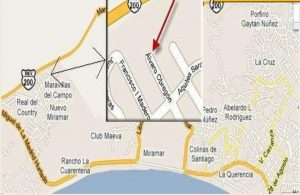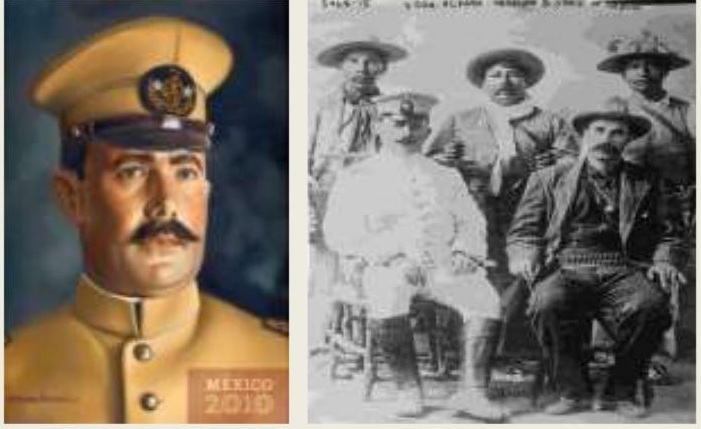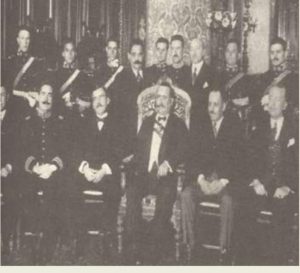By Terry Sovil from the July 2011 Edition
 1880-1928
1880-1928
February 19, 1880 Birth at Alamos, Mexico
February 1913 Huerta overthrows Madero
August 15, 1914 Occupies Mexico City
April 6 – 13, 1915 Battle of Celaya
May 1, 1917 Retirement
April 1920 Out of retirement
April 23, 1920 Plan of Agua Prieta
December 1, 1920 until December 1, 1924
President of Mexico
July 17, 1928 Death in Mexico City
Alvaro Obregón was born on a hacienda in Novojoa, Sonora and attended school in Huatabampo and Alamos. He taught primary school but was a very good chickpea (garbanzo) farmer due to application of scientific principles. His intelligence and memory helped him to become one of the finest generals in Mexican history.
Francisco Madero had started a revolt against Porfiro Díaz in 1910. Obregón’s nephew and friend had become a supporter of Madero. Obregón was more concerned about his two children as he was now a widower. His commitment was to his children and his community. He ended up as President of his local community and led a small army against the invasion of Sonora by Pascual Orozco in 1912.
When Victoriano Huerta ousted Madero in 1913 he had Madero murdered. Sonora rebelled and Obregón joined recruited them into an army. Obregón proved to be an effective military commander and an astute politician.
In June, 1914 Venustiano Carranza promoted him to General and he commanded the Army of the Northwest. After Huerta’s fall in 1914, Carranza, Pancho Villa and Emiliano Zapata vied for power. Obregón backed Carranza. At the Convention of Aquascalientes he spoke out for Carranza but the convention did not back him. Obregón fought Villa at Trinidad, León and Celaya.
At the battle of Santa Ana del Conde Obregón lost his right arm. As he stood on a tower viewing the battlefield a shell exploded and shattered his right arm. Obregón was certain he was bleeding to death so he pulled his pistol and attempted to shoot himself in the temple. Fortunately, his aide had cleaned the pistol the night before, removed the shells and forgot to replace them. His men took him to the hospital.
Villa’s preference in battle was mass cavalry charges.
Obregón, from reading news of World War I, used barbed wire, trenches and machine guns. His disciplined army beat Villa down from a formidable enemy to an inconvenience. Villa respected Obregón. When Obregón went to Chihuahua to speak for Carranza, Villa had ordered him shot and took him into custody. Obregón told Villa it would be a favor as it would make him a martyr. As he waited for the firing squad he played cards. He would go back over the exact sequence of cards played after each game totally astounding his captors. Villa finally allowed him to leave and he returned to Mexico City.
Obregón became Secretary of War under Carranza. He was a delegate to the Constitutional Convention of 1919 in Querétaro but quietly broke ranks when liberal and radical articles, not wanted by Carranza, were adopted. Obregón kept quiet but privately encouraged the leftists. When the Constitution was adopted in 1917 he returned to private life in Sonora where he had a large farm and several businesses.
He cultivated friends and associates and in 1919 announced his candidacy for the presidency after carefully laying groundwork among supporters.
Carranza tried to have an engineer put in as president but the Sonora group – Obregón, Calles, de la Huerta, Hill—overthrew him. Carranza was shot trying to flee to Veracruz. Elections were held and Obregón won.
At first the United States would not recognize Obregon’s government. Obregón needed recognition to reduce the risk of a revolt against a perceived weak leader and for credits to help rebuild a war-torn Mexico. Finally, after much discussion the United States recognized the Obregón government as part of a gentlemen’s agreement reached at the Bucareli Conference in Mexico City, May-August 1923. Obregón managed to keep peace among the various revolutionary cliques but fought against implementation of some constitutional provisions.
Obregón was a good speaker and frequently used humor.
He once noted that “no Mexican general could withstand a cannonade of 50,000 silver pesos”. He also explained that they had found his severed arm by throwing a silver peso in the air and his detached arm reached up and caught it. He was not a man to offend. He had a temper, one could die for crossing him. He demanded, and got, loyalty from persons of all types.
He decided to run for president again in 1927 and succeed Calles. They were able to get the constitution amended and Obregón easily won. On July 7, 1928 he joined friends in a celebratory banquet. A young man named José León Toral shot him dead to avenge the execution of fellow Catholic fanatics..

Download the full edition or view it online
—
Terry is a founding partner and scuba instructor for Aquatic Sports and Adventures (Deportes y Aventuras Acuáticas) in Manzanillo. A PADI (Professional Association of Dive Instructors) Master Instructor in his 36th year as a PADI Professional. He also holds 15 Specialty Instructor Course ratings. Terry held a US Coast Guard 50-Ton Masters (Captain’s) License. In his past corporate life, he worked in computers from 1973 to 2005 from a computer operator to a project manager for companies including GE Capital Fleet Services and Target. From 2005 to 2008, he developed and oversaw delivery of training to Target’s Loss Prevention (Asset Protection) employees on the West Coast, USA. He led a network of 80+ instructors, evaluated training, performed needs assessments and gathered feedback on the delivery of training, conducted training in Crisis Leadership and Non-Violent Crisis Intervention to Target executives. Independently, he has taught hundreds of hours of skills-based training in American Red Cross CPR, First Aid, SCUBA and sailing and managed a staff of Project Managers at LogicBay in the production of multi-media training and web sites in a fast-paced environment of artists, instructional designers, writers and developers, creating a variety of interactive training and support products for Fortune 1000 companies.




You must be logged in to post a comment.